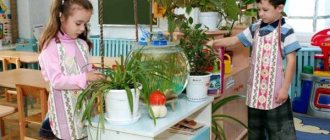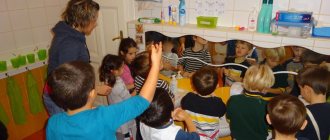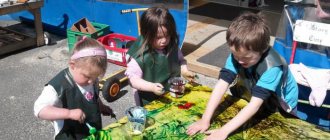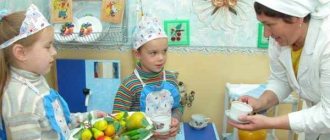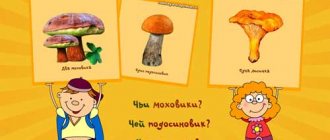Abstract on the organization of household work in the preparatory group “Household Services”
Abstract on the organization of household labor
in the preparatory group "Household Services"
Goal: developing a positive attitude towards work and its results.
Objectives: 1. To teach children to participate in the organized work of a group of peers, to correlate their activities with the work of others and to understand that the work of the subgroup in which they work is part of the common cause of the team. 2. Improve labor skills and abilities in the work process, improve the ability to plan your activities, distributing responsibilities among yourself, and evaluate the work of your group and the team as a whole. 3. Strengthen the ability to correctly use materials and work equipment, observing safety precautions. 4.Form a belief in the social significance and necessity of domestic work. 5.Cultivate friendly relationships in the work process.
6. Replenish children’s vocabulary with expressions - cleaning company, household service. Materials: 1. Drawing cards (applications) depicting: a) table, chair, basin of water, cloth; b) books, glue, scissors, measuring stick, pencils, napkin, colored paper, stand. 2. 2 diagrams depicting the sequence of operation. 3. easel Equipment: basins with water, rags for all children, aprons, glue, strips, papers, scissors, napkins, sockets, sponges.
Preliminary work:
- learning proverbs and sayings about work, participating in the game “Household Service”,
- introduction to professions.
Methods and techniques: conversation, problematic questions, artistic expression, practical work, explanation, demonstration, analysis, games (submission of applications)
Progress:
-Who do you think is a hardworking person?
-Guys, you know that there are services that come to help people. What services are these? (children's answers)
Amazing. And there is a service that comes to the aid of people. This is the Household Service. What services do you think this service provides (Washes, washes..) What do the household service workers do? (help people)
-Guys, would you like to work in the consumer service and help people? Would you like to organize your own household service in our group?
-Do you know how welfare workers organize their work? (Answers)
They fulfill requests received from people. So our service has received applications.
1. From Zinaida Petrovna, wash the chairs.
2. From the middle group teacher, seal the books.
To fulfill these requests, we need to divide into 2 teams. Each team must have a foreman.
-Which team will repair the books?
-What material do you need to prepare to complete the order? (children’s answers)
-Distribute responsibilities yourself.
-What material is useful for washing chairs? (children’s answers)
-The foreman assigns responsibilities to each team member.
-Well, skillful hands do not know boredom. Get to work.
— Hint cards will help you in doing the work. (Schemes are displayed on the easel)
Children disperse into teams to work places, taking work equipment with them.
The teacher can:
1.help one of the children.
2. ask the child what he is doing, ask another how he is doing, what he will do next.
3 - invite the child who finished his work first to help one of the children. 4 – give the instruction “Finish your work. The customer is waiting for us. Having finished all the work, the children put the work equipment back in place, then the teacher calls the children to him. D: We are ready. Work is done. — I’ll ask the foremen to report on the work done. How did you do the work? What did you do best?
Will the customer be satisfied? Did you enjoy fulfilling orders? (foremen answer)
D: — We did our work carefully, carefully, conscientiously, cleanly, helped a friend, tried to make it beautiful and please the customer
say proverbs about work (Whoever is not afraid of work shuns laziness. Patience and labor will grind everything. What you sow, so will you reap. Labor feeds a person, but laziness spoils him.) Q: - Each of you did your job, and together We did a great job. As are the masters, so are the deeds. Well done. Our Household Service has finished its work. Thanks to all. Rest.
Artistic work in preschool educational institutions
Artistic work in preschool educational institutions
(based on personal work experience)
The Concept for the Modernization of Preschool Education emphasizes the priority of solving problems aimed at creating a creative atmosphere and conditions for innovative activity. The authors of the Concept point out that the child, first of all, is introduced to eternal universal values (beauty, goodness, truth). As a result of this, he is born and develops such core personality qualities as independence, initiative, arbitrariness in the form of a desire to overcome difficulties, as well as the need for active development and creative transformation of the surrounding reality
In the target guidelines of the Federal State Educational Standard for Preschool Education, a child at the stage of completing preschool education must have a developed imagination, which is realized in various types of activities; the child must have a positive attitude towards the world, towards different types of work at the stage of completing preschool education
The creative principle in a person is always a striving forward, for the better, for progress, for perfection and, of course, for beauty in the highest and broadest sense of this concept. It is this kind of creativity that manual labor in preschool age fosters in a person, and in this function it cannot be replaced by anything.
Artistic manual labor is the work of a child with various materials in order to create useful and artistically - aesthetically significant objects and products to decorate his life, games, work and leisure. This child labor is a decorative, artistic and applied activity, since the child, when creating beautiful objects, takes into account the aesthetic qualities of materials based on his ideas, knowledge and practical experience acquired in the process of work.
The purpose of artistic work is the directed and consistent education of aesthetic and everyday culture in children, promotion of personal growth and the formation of an emotional and value-based attitude towards the world around them.
Preschool age provides excellent opportunities for developing creativity. And the creative potential of an adult will largely depend on the extent to which these opportunities were used.
The main directions in the development of creative abilities of children of senior preschool age through manual labor are: the development of imagination and the development of thinking qualities that form creativity. When organizing manual labor, I take into account the main stages of children’s creative activity:
Stage 1 - the emergence of a plan;
Stage 2 - the process of creating a product of creative activity;
Stage 3 - analysis of the results.
When working with preschoolers, I always comply with the following conditions:
– I organize classes in such a way as to bring a positive emotional attitude to children and to educate children in moral concepts;
– I take into account the interests of boys and girls;
– To give the classes a teaching and developmental character, I complicate technical and visual means;
– I take into account the age and individual characteristics of children;
– each craft always finds a specific practical application;
The results of productive activities always receive approval, praise and are advertised to parents and other groups.
Working in this direction, I use effective methods and techniques: musical accompaniment, compliance with safety rules when working with scissors, demonstration and explanation, use of artistic expression, consideration of work sequence diagrams, activation of children’s speech, finger gymnastics, practical activities of children, clarifying questions about the sequence of tasks, assistance to children from an adult and a child, analysis, self-esteem of children.
Children actively work with various materials: fabric, foam rubber, polystyrene foam, various types of paper (plain, corrugated, newspaper, napkins, cardboard), natural materials (cones, conifer needles, bark, fruit and berry seeds, etc.), Waste material (reels, boxes, etc.)
To maintain interest in manual labor and the desire for independence, we make crafts that do not require complex processing and require minimal time, since preschoolers cannot wait long for the result of their labor.
When analyzing the work, I draw the children’s attention to the neatness of the craft and its individuality. Before starting to make crafts, I conduct conversations with children to familiarize themselves with the properties of materials, and talk about the use of these materials in everyday life. Children began to bring various textures of fabrics, papers, etc. to kindergarten. As a result, we have collected entire collections that children love to look at and tell where these wonderful materials came from. We photograph all the crafts and collect them in an album.
All the crafts made by the children’s hands “live” in the group’s theater, are collected for playing out games with construction sets, a reception area is decorated, and donated to other groups, i.e. all the crafts are appreciated and treasured with gratitude to the children. Children see this and strive for other successes, they have new fantastic ideas, a desire to do something nice for others. As a result, children develop a system of certain skills, knowledge and abilities for making crafts.
My children love working with paper. They have mastered the following kaka actions: bending, cutting, tearing and tearing, and gluing. Through experimenting with paper, children learned that paper can be soft, hard, of varying thickness and strength, shiny and matte, and of all kinds of colors. The children themselves came to the conclusion that they could act with her in different ways. Each time, using paper of different quality, the children experienced more or less stress, which had a positive effect on the development of fine motor skills. Didactic games “What’s rustling?”, Guess by touch, etc. helped develop auditory attention in children.
I have always paid great attention to assessing children's activities, teaching children to see what worked well and what did not. And most importantly - why, what else needs to be learned. I drew the children's attention to the originality of the idea and the unusual method. In our group, a tradition was born - decorating the hall for the holidays. And this is very responsible and my students always coped with this task well, received the approval of adults and words of gratitude. I think that this side of education will help children in school to be careful with their possessions at school and at home.
All materials are concentrated in the labor corner. They are always available and safe for children. Together with children and parents, we replenished our magical corner.
Of course, such success cannot be achieved without parents. The parents of my students have always been active participants in the holidays, jointly making decorations, details for costumes, and joint creative exhibitions. I believe that the main thing is that children have acquired interest, desire, an emotional mood has been created, children began to understand that in any activity you need to put in effort and patience, and then you will receive satisfaction and high appreciation from friends and adults. Parents' help helped children not to leave work unfinished when difficulties encountered.
As a result, children became liberated, active, kind and responsive, and more sociable. Children acquired a strong interest in various types of construction and manual labor. When making crafts, they use knowledge about materials, which helps them create durable and beautiful crafts for use in play and long-term preservation. My graduates are ready for school. I am sure that they will be active participants in creative exhibitions.
Summary of the lesson “Household Services”
Household work in the preparatory group"Household Service"
Target:
To develop in children the simplest labor skills, skills that are manifested in everyday activities.
Tasks:
—Educational
: Organize children’s activities to master the skills of caring for indoor plants, repairing books and developing skills in washing doll clothes.
— Developmental
: Promote the development of communication skills through the ability to collaborate in small groups.
-Educational:
To cultivate the habit of work effort and such personality traits as independence, accuracy, mutual assistance, caring for each other, and responsibility for a common cause.
To form in children a positive attitude towards work, its results, and a desire to work for others .
Equipment:
1.
Application cards with images.
2.
3 basins of water, 5 rags, 2 sponges, 2 brushes, 2 empty basins,
2 trays;
3.
Aprons for all children, 3 pairs of arm sleeves, soap, soap dish,
2 tablecloths
Methods and techniques
:
• Visual - observations, looking at pictures.
• Practical - training in certain methods of performing labor operations (how to wring out a cloth so that water does not flow down the sleeves, etc.).
• Verbal – questions, conversations, use of literary words, directions.
Preliminary work:
learning proverbs and sayings about work, participating in the game “Household Services”, getting to know professions.
Progress of the lesson:
Guys, you know that there are services that come to help people. What services are these? (Answers).
Well done. And there is a service that provides services to people. This is a household service. What services do you think this service provides? (Washes, washes,...) Yes, this service cleans apartments, washes windows, washes and cleans things. What do welfare workers do? (Help people). — Guys, did you want to work in the consumer service and help people? Would you like to organize your own household service in our group? In our kindergarten, in our group, who do you think we could help? (To the junior teacher). How can we help Anzhelika Romanovna? — Do you know how welfare workers organize their work? (Answers).
They fulfill requests received from people. Our consumer service also received applications from Anzhelika Romanovna. To complete these requests, we need to split into 3 teams. Every team must have a captain. Let's choose captains, and they will choose their assistants, who wants to be captain? (Children choose captains.)
Captains, pull out job applications for yourself. Approach your teams and discuss together what do you need to do your job? (Discussion in progress).
- Which team will work here and repair our books? First we need to measure a strip of the required length. To do this, you place the strip in front of you, place the book on the strip with the spine facing you .
Align the spine of the book and the edge of the strip well
.
Make a mark with a pencil, then cut along the mark line.
First bend this strip in half, ironing the fold well, and then straighten it again, apply glue to the inside. Now you need to very carefully fold the pages in the book and straighten everything out evenly. Place the strip coated with glue on the lining. Place the book with the spine on the strip so that the pages are facing you .
Place the book up to the fold of your strip, then fold the other half of the strip and glue it to it. Use a napkin. Now press down well so that the glue does not seep out from under the paper. Here the book is glued.
— Who will wash the window sills and water the flowers? We will water our plants, wipe the large leaves with a cloth, wipe away the dust from the fleecy ones with a dry brush, and spray the small leaves. Let's put on aprons. We will wipe the large leaves of the sansevieria with a wet cloth. We take a cloth, wet it in a basin of water, then wring it out thoroughly and spread it on the palm of our hand. We support the sheet from below with one hand, and with the other we wipe the sheet from above, then from below. Carefully brush off the dust from the violet's fuzzy leaves with a dry brush. We will spray plants with small leaves, such as nephrolepis and chlorophytum. - Is everything clear to everyone? Then we begin work and choose the flowers that we will care for.
— Which team will be responsible for washing the prepared linen? But first we need to prepare our work area and get ready to do the laundry. Spread out the oilcloth. For what? (so as not to wet the tables). We put basins, pour water, put on aprons. Now everything is ready.
The teacher offers to go to their workstations and start working. But before they started working, the children, together with the teacher, remembered the rules for safe handling of objects of work. During work, the teacher gives advice, helps with organization, and gives instructions on how it is more convenient to stand near the basins so as not to disturb each other. He asks the children to tell and show the techniques for washing by hand (wet the item, soap it, rub it, rinse off the soap, wring it out). I remind you that you also need to start rinsing with white laundry. I show you how to rinse. What should you do with rinsed laundry? That's right, straighten it, shake it and hang it on a rope. (A recording of cheerful music sounds)
- Now, please, clean up your work places and throw out the water. Now come to me and let's see if all the requests have been completed. —Whose team put the toys in order? Captain, please tell us how you worked? Were there any difficulties? — Who washed the clothes? Have you done everything yet? Well done!
— Did the team washing the window sills complete their task? Good - It turned out that everyone did their own little thing, but everyone did one big thing together. Our group now has cleanliness and beauty. Let's now call our Angelica Romanovna that she accepted your work. Anzhelika Romanovna, are you satisfied with the work of our consumer service? Have all your requests been completed? (Answer from the junior teacher) and presentation of medals to team captains. — Guys, did you like helping? Then let's keep our group clean.
